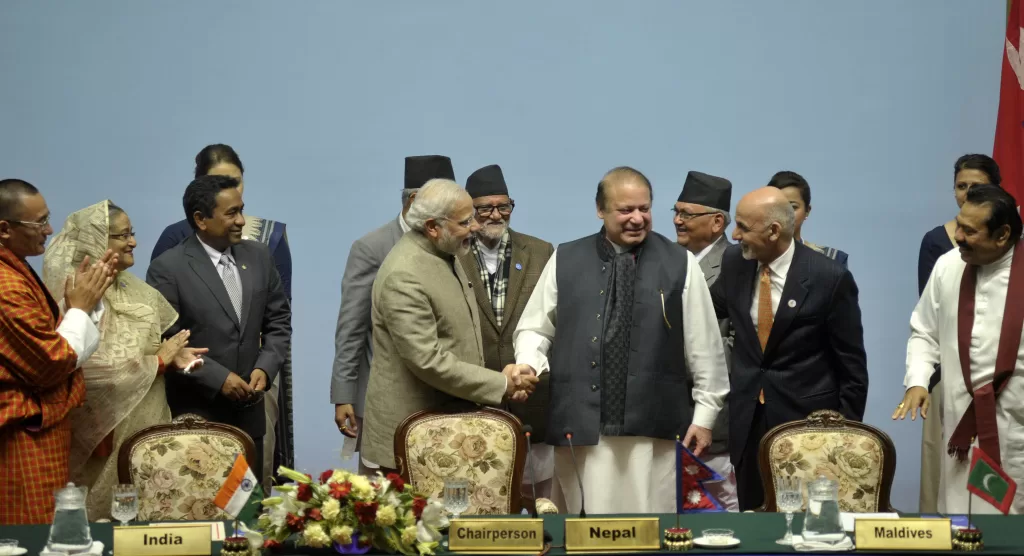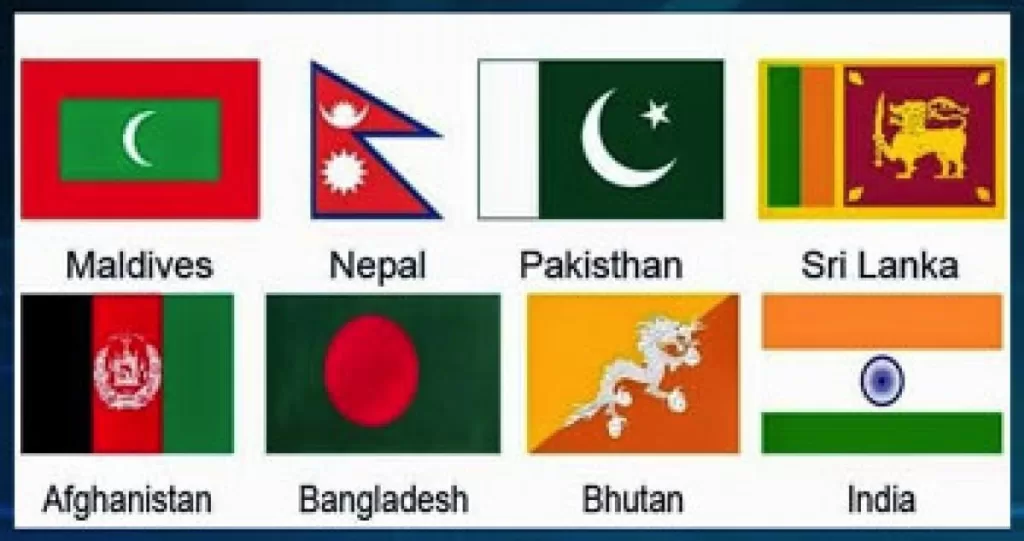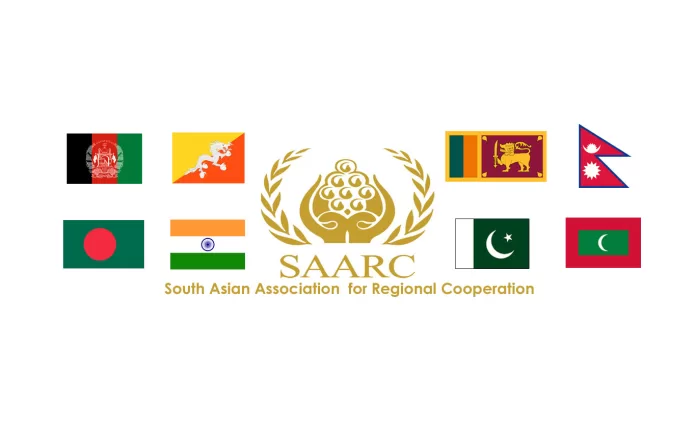The South Asian Association for Regional Cooperation (SAARC) was established on December 8, 1985, with the signing of the SAARC Charter by the heads of state or government of its original seven members: Bangladesh, Bhutan, India, Maldives, Nepal, Pakistan, and Sri Lanka. Afghanistan joined as the eighth member in 2007. In its early years, SAARC focused on building mutual trust and creating a platform for regional cooperation. The member countries recognized the potential benefits of working together to address common challenges. SAARC was established with a set of ambitious objectives aimed at fostering cooperation, development, and stability within the South Asian region. The reason behind it was the intra-region conflicts between the countries including Partition of India (1947), Kashmir Conflict (Since 1947), Bangladesh Liberation War (1971), Sri Lankan Civil War (1983-2009), Nepal Civil War (1996-2006) and Afghanistan Conflict.
The 1990s saw SAARC diversifying its areas of cooperation. The organization expanded its focus from primarily economic aspects to encompass social, cultural, and environmental issues. The SAARC Charter was amended in 2004 to include provisions for cooperation in new areas, such as agriculture, rural development, and poverty alleviation. This reflected a growing recognition of the need for comprehensive development strategies. Despite challenges, SAARC has continued its efforts to promote regional cooperation. However, periods of strained bilateral relations, particularly between India and Pakistan, have at times hindered the organization’s progress.
SAARC has facilitated regular interactions among member countries, fostering mutual understanding and cooperation. The organization has launched initiatives in areas such as health, education, and disaster management, contributing to collective efforts in addressing regional challenges. The South Asian Free Trade Area (SAFTA), initiated in 2006, aimed to promote trade among member countries, although its implementation has faced challenges.
Challenges
Bilateral tensions, particularly between India and Pakistan, have at times hampered SAARC’s effectiveness in achieving its objectives. Differences in political, economic, and developmental priorities among member countries have posed challenges to consensus-building. Geopolitical factors and security concerns have occasionally hindered the successful execution of regional initiatives as explained in succeeding paras.
Conflictual Relations
Historical conflicts between member countries significantly impact the spirit of cooperation within SAARC. Deep-rooted conflicts, such as the India-Pakistan rivalry over Kashmir, can create an atmosphere of mistrust and reluctance to engage in meaningful collaboration. The existence of unresolved disputes often diverts attention and resources away from the organization’s objectives, undermining its ability to foster effective regional cooperation.
Bilateral Rivalries
Ongoing bilateral rivalries, notably the tensions between India and Pakistan, can hinder the prospects of effective regional cooperation. These rivalries often result in a lack of political will to engage constructively within the SAARC framework. The preoccupation with bilateral disputes, such as border issues or historical grievances, can overshadow broader regional development goals and prevent the organization from realizing its full potential.
National Interests
The pursuit of national interests can sometimes take precedence over regional cooperation efforts. Member countries may prioritize their own economic, political, or strategic agendas over collaborative initiatives within SAARC. This divergence in priorities can hinder consensus-building and lead to disputes over resource allocation, trade policies, and the implementation of regional projects.
Security Concerns
Security concerns, particularly those related to terrorism and cross-border conflicts, can cast a shadow over regional integration efforts. The presence of extremist groups or the fear of instability can lead countries to adopt protectionist measures and border controls, undermining the spirit of openness and cooperation that SAARC aims to foster. Security issues can deter member countries from fully engaging in cross-border initiatives and hinder the free movement of goods, services, and people.
Political Instability
Political instability within member countries can disrupt the continuity of SAARC’s initiatives. Changes in leadership, domestic conflicts, and frequent regime changes can lead to shifts in foreign policy priorities, which in turn affect the level of commitment and engagement in regional cooperation efforts. Political uncertainty can undermine the consistency required for the successful implementation of long-term projects.
Uneven Development Levels
Differences in economic and developmental levels among SAARC member countries pose a challenge to effective cooperation. Disparities in wealth and resources can lead to unequal contributions and benefits within the organization. Developing countries may feel disadvantaged by the dominant influence of more developed nations, impacting the overall willingness to engage in collaborative efforts.
Lack of Institutional Capacity
SAARC’s organizational structure and decision-making mechanisms may lack the capacity to effectively address complex regional challenges. Bureaucratic inefficiencies, slow decision-making processes, and inadequate resource allocation can hinder the timely execution of initiatives and responses to emerging issues.

Case Studies of Conflicts and SAARC
India-Pakistan Conflict: Impact on Regional Cooperation
The longstanding India-Pakistan conflict has had a profound impact on SAARC’s ability to foster regional cooperation. The conflict, particularly centered on the disputed region of Kashmir, has resulted in deep-seated mistrust and tense bilateral relations. This tension often spills over into SAARC meetings, where political differences and security concerns dominate discussions. The animosity between India and Pakistan has led to instances where SAARC summits have been canceled or postponed due to diplomatic disputes. The focus on security concerns and the prioritization of national interests have at times overshadowed SAARC’s development-oriented goals. The reluctance of India and Pakistan to engage in meaningful cooperation has limited the organization’s effectiveness in addressing shared challenges and realizing its full potential for regional integration.
Nepal-India Relations: Impact on SAARC Initiatives
Bilateral issues between Nepal and India have had repercussions on their participation in SAARC initiatives. The close geographical and cultural ties between these countries have led to both cooperation and tensions. For instance, the 2015 Nepal earthquake exposed underlying tensions between the two nations, as Nepal criticized India’s relief efforts. This strained relationship has affected Nepal’s engagement in SAARC activities. When bilateral relations are strained, participating countries may lack the necessary trust and confidence to fully collaborate within the SAARC framework. The potential for mutual support and solidarity, which are crucial for effective regional cooperation, can be compromised by such bilateral issues.
Sri Lanka’s Civil War: Impact on SAARC’s Peace Initiatives
The Sri Lankan civil war, which lasted from 1983 to 2009, had implications for SAARC’s efforts to promote peace and stability in the region. The conflict between the Sri Lankan government and the Liberation Tigers of Tamil Eelam (LTTE) led to significant loss of life and displacement. SAARC’s attempts to facilitate dialogue and mediation were hindered by the complexity and intensity of the conflict.
Additionally, the civil war diverted the attention of member countries, making it challenging for SAARC to garner unified support for peace initiatives. While SAARC aimed to address the conflict’s humanitarian and security dimensions, the involvement of external powers and the internal complexities of the Sri Lankan conflict underscored the limitations of regional organizations in resolving deeply rooted conflicts.
EFFORTS TO OVERCOME CHALLENGES
SAARC Summits: Addressing Conflicts and Fostering Dialogue
SAARC summits serve as crucial platforms for member states to come together, discuss shared challenges, and foster dialogue. Despite conflicts and historical tensions, these summits offer an opportunity for leaders to engage in face-to-face interactions, which can lead to better understanding and increased trust. While the focus of these summits often extends beyond conflict resolution, the diplomatic environment created by such meetings can facilitate informal discussions and sideline dialogues that contribute to reducing tensions. SAARC summits also provide a chance for leaders to demonstrate their commitment to regional cooperation, sending positive signals to their populations and the international community.
Conflict Resolution Mechanisms: Promoting Peaceful Solutions: SAARC has established conflict resolution mechanisms to address disputes and conflicts among member countries. The SAARC Charter emphasizes the peaceful settlement of differences and disputes through dialogue and negotiations. One such mechanism is the SAARC Ministerial Meeting on Dispute Settlement, which provides a platform for countries to raise concerns and seek resolutions. While the effectiveness of these mechanisms can vary based on the willingness of member countries to engage and compromise, they demonstrate SAARC’s commitment to preventing conflicts from derailing regional cooperation.
Economic Cooperation: Transcending Conflicts for Mutual Benefits
Economic cooperation within SAARC has shown instances of transcending conflicts for the sake of mutual benefits. The South Asian Free Trade Area (SAFTA), despite facing challenges in full implementation, demonstrates efforts to create a common market for goods and services. Member countries recognize that economic interdependence can foster stability and growth, even in the presence of political disputes. Initiatives such as SAFTA encourage countries to set aside conflicts temporarily to pursue shared economic interests, thereby promoting confidence-building measures and improving overall regional relations.
Sub-regional Initiatives: Navigating Bilateral Tensions
SAARC’s sub-regional initiatives, such as the Bangladesh-Bhutan-India-Nepal (BBIN) Motor Vehicle Agreement, offer avenues for smaller groups of countries to collaborate on specific projects. These initiatives help navigate around bilateral rivalries and address common concerns in a more pragmatic manner. By focusing on sub-regions and areas of mutual interest, SAARC can work around larger conflicts and foster tangible outcomes that benefit member countries directly.
People-to-People Contacts: Building Trust from the Ground Up
Promoting people-to-people contacts, cultural exchanges, and educational programs can play a role in building trust and reducing conflicts. These initiatives create opportunities for citizens of member countries to interact, fostering understanding and empathy. When individuals from different countries engage in positive interactions, it can contribute to changing perceptions and attitudes at the grassroots level, ultimately influencing political dynamics.

FUTURE PROSPECTS
Reforms within SAARC
To overcome the challenges it faces, SAARC could benefit from internal reforms that enhance its efficiency, effectiveness, and relevance. Some potential reforms includes streamlined decision-making, conflict resolution mechanisms and prioritizing economic integration initiatives like SAFTA and focusing on addressing economic disparities among member states could foster a sense of shared prosperity and cooperation.
Sub-regional Initiatives
Given the complexities of bilateral and regional conflicts, sub-regional initiatives offer an alternative path to foster cooperation. By focusing on smaller groups of countries that share common interests and geographical proximity, SAARC can navigate around larger conflicts and achieve tangible outcomes. Initiatives like the BBIN Motor Vehicle Agreement could serve as models for effective sub-regional collaboration that promotes mutual benefits and trust-building.
External Influences
External powers have the potential to both exacerbate and mitigate conflicts within South Asia. External powers that have strategic interests in the region may exploit existing conflicts to advance their agendas. Their support for various factions or involvement in disputes can intensify tensions and undermine regional stability. Conversely, responsible external powers can play a constructive role in conflict resolution by encouraging dialogue, offering mediation, and promoting diplomatic solutions. International pressure and engagement can incentivize member countries to prioritize regional stability over narrow national interests.
CONCLUSION
The future of SAARC lies in its ability to adapt, innovate, and foster genuine cooperation in the face of historical conflicts, political rivalries, and diverse national interests. By implementing internal reforms, promoting sub-regional initiatives, understanding and managing external influences, and prioritizing shared development goals, SAARC can pave the way for a more integrated, peaceful, and prosperous South Asia. The journey ahead may be complex, but the potential for positive change and regional transformation remains within reach.




